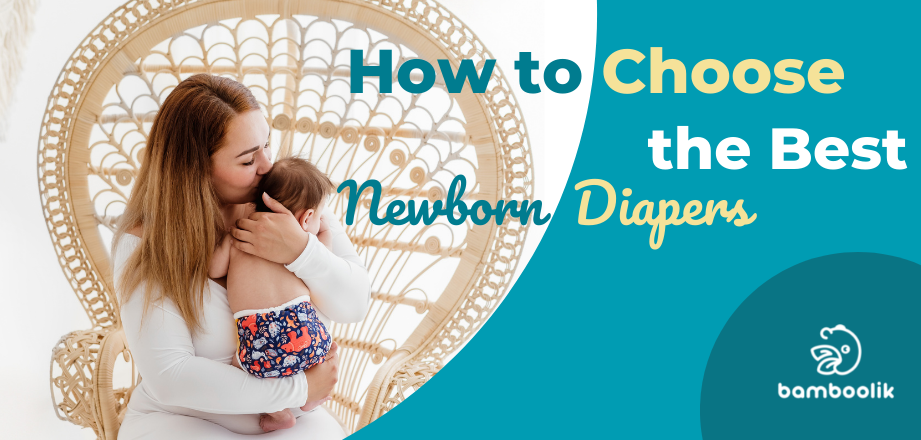Tiny body, short legs and uncoordinated movements. How to choose diapers for a newborn that would fit the best? We’ve been making diapers for over 10 years now and got plenty of experience. Read our tips!
Newborn Diaper Size
If you’ve chosen disposable diapers, you need size 1. It’s the smallest and even that could be a tad big in the first days. But don’t worry! Your baby will fit the size 1 diaper soon. In fact, they might grow out of it very soon, too. Therefore, we don’t recommend stocking up on this diaper size much – you never know how fast your baby will grow.
With cloth diapers, the situation is a bit different. Parents often consider whether they should buy cloth diapers in newborn size or whether the one-size cloth diapers will suffice. We understand that dilemma very well – it’s an uncertain investment as your baby might grow out of the newborn size very soon. Or they might not. We know for a fact that some babies grow out of newborn diapers in four weeks while some still wear them at six months.
Our customers usually purchase a diaper set of one-size diapers (usable from approx. 3,5 to 15 kg). If their newborn turns out to be very tiny, they buy a few newborn diapers once they know for sure that they need them. Even the newborn size of cloth diapers is adjustable – you simply fasten the snaps in the front to make the diaper smaller and when your baby grows, you unsnap them and enlarge the diaper.
Another alternative for a tiny newborn is to use muslin squares during the first few weeks (with waterproof Diaper Covers over the squares). Which is by the way a very efficient way to save a considerable amount of money on diapers. Read this article to find out how much your savings could be.
In case you’re not sure how to fold a muslin square for a newborn, have a look at our video here :
What to Look out for when Choosing Newborn Diapers
Any diaper, and especially a newborn sized one, should have a snug fit and never limit the baby in moving their legs freely. The hems of the diaper should sit right in the groins. If you struggle to make it stay there, roll it up once you put the diaper on. Don’t overdo it with absorbing inserts either – it’s better to change your baby’s diaper more often than to make their bum too bulky.
If you want to make sure the fit is right, get yourself a newborn fitted diaper. It fits babies from 2 kg and its size is adjustable, making it last much longer than disposable diapers No. 1. It fits babies up to 6 kg or even longer, depending on their proportions.
Keeping the bum dry is also very important when choosing a diaper for your newborn. Most newborns sincerely hate feeling wet; in addition, their sensitive skin might react to wetness. For cloth diapers users, this problem is solved by Stay Dry Diaper Liners – they direct wetness away from the skin and make your baby feel comfortably dry even in a wet diaper. You simply lay them on your diaper so that they’re placed as the next-to-skin layer, sheltering your baby’s bum from wetness.
Diaper liners also make your life easier when getting rid of poo. You simply shake it out into the toilet, leaving the diaper just wet, without any solid bits to deal with. Stay Dry Diaper Liners are reusable and they wash well, they’re not prone to stains.
We also offer disposable diaper liners which you can throw away entirely, smelly content included.
How to Change a Newborn Diaper
A diaper change could be done literally anywhere, even in the middle of the woods, we’ve done that :-) But such adventurous activities can wait till your newborn grows a little. At the beginning, your main changing action will certainly happen at home. We suggest you set up a nice and comfortable changing station in a cosy nook.
We highly recommend letting your baby kick around freely (read: naked) during each diaper change. Let them explore their limbs, perform some belly action, stretch, let the bum get some air. This is a great prevention against the dreaded newborn tummy aches as well as against diaper rash. Just protect your changing station with a waterproof changing mat or use at least a spare muslin square. Accidents happen.
Bum Creams
Our last tip regards baby bottom care. Use creams sparingly. A thick layer of cream might clog up the pores and dry the skin out unnecessarily. Use creams only when there’s a problem that needs your attention and don’t forget to air the skin regularly during diaper changes. Wash your baby’s bottom preferably with just water and some gentle soap. Or opt for a gentle cleansing Happy Bottom Oil (or get an entire Happy Bottom Kit).
Do you have questions about newborn diapers? Contact us (use the chatbox here on the website, write an e-mail to us or get in touch via our social media) or call our hotline.

